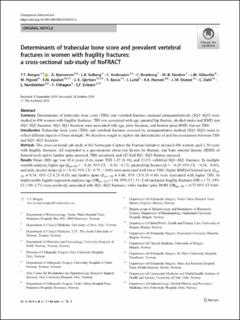| dc.description.abstract | Summary - Determinants of trabecular bone score (TBS) and vertebral fractures assessed semiquantitatively (SQ1–SQ3) were studied in 496 women with fragility fractures. TBS was associated with age, parental hip fracture, alcohol intake and BMD, not SQ1–SQ3 fractures. SQ1–SQ3 fractures were associated with age, prior fractures, and lumbar spine BMD, but not TBS.
Introduction - Trabecular bone score (TBS) and vertebral fractures assessed by semiquantitative method (SQ1–SQ3) seem to reflect different aspects of bone strength. We therefore sought to explore the determinants of and the associations between TBS and SQ1–SQ3 fractures.
Methods - This cross-sectional sub-study of the Norwegian Capture the Fracture Initiative included 496 women aged ≥ 50 years with fragility fractures. All responded to a questionnaire about risk factors for fracture, had bone mineral density (BMD) of femoral neck and/or lumbar spine assessed, TBS calculated, and 423 had SQ1–SQ3 fracture assessed.
Results - Mean (SD) age was 65.6 years (8.6), mean TBS 1.27 (0.10), and 33.3% exhibited SQ1–SQ3 fractures. In multiple variable analysis, higher age (βper SD = − 0.26, 95% CI: − 0.36,− 0.15), parental hip fracture (β = − 0.29, 95% CI: − 0.54,− 0.05), and daily alcohol intake (β = − 0.43, 95% CI − 0.79, − 0.08) were associated with lower TBS. Higher BMD of femoral neck (βper SD = 0.34, 95% CI 0.25–0.43) and lumbar spine (βper SD = 0.40, 95% CI 0.31–0.48) were associated with higher TBS. In multivariable logistic regression analyses, age (ORper SD = 1.94, 95% CI 1.51–2.46) and prior fragility fractures (OR = 1.71, 95% CI 1.09–2.71) were positively associated with SQ1–SQ3 fractures, while lumbar spine BMD (ORper SD = 0.75 95% CI 0.60–0.95) was negatively associated with SQ1–SQ3 fractures. No association between TBS and SQ1–SQ3 fractures was found.
Conclusion - Since TBS and SQ1–SQ3 fractures were not associated, they may act as independent risk factors, justifying the use of both in post-fracture risk assessment. | en_US |

